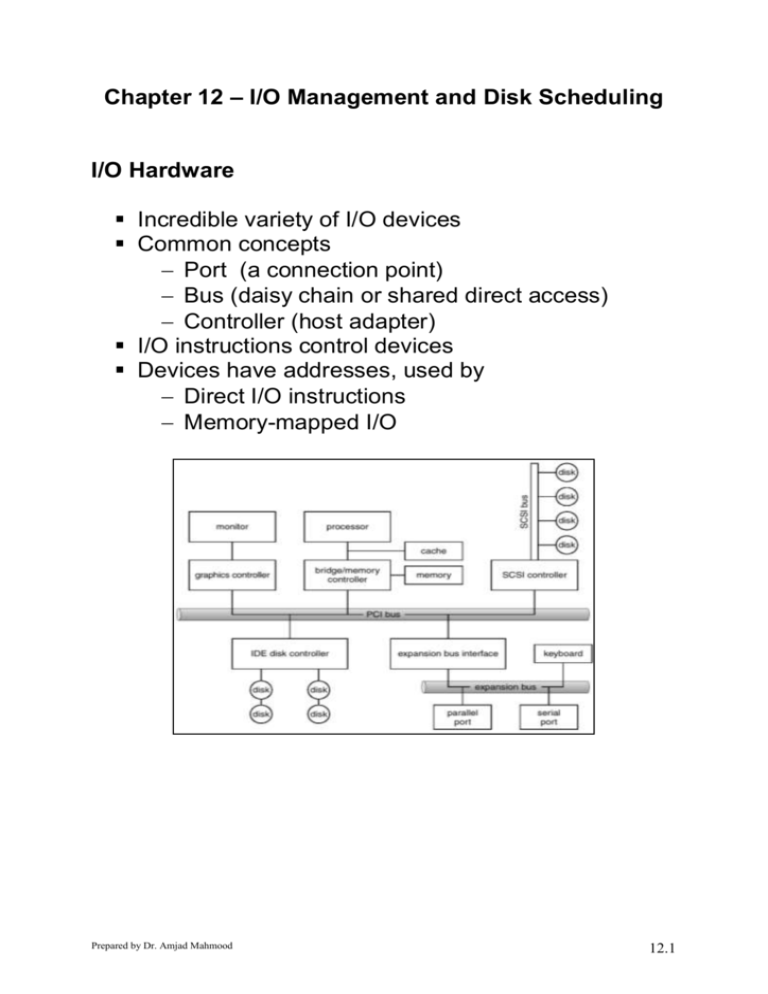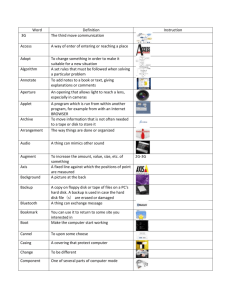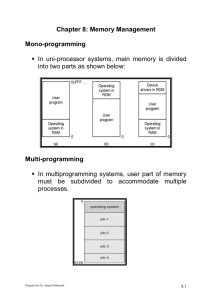Chapter12-Disk Scheduling(1)
advertisement

Chapter 12 – I/O Management and Disk Scheduling I/O Hardware Incredible variety of I/O devices Common concepts Port (a connection point) Bus (daisy chain or shared direct access) Controller (host adapter) I/O instructions control devices Devices have addresses, used by Direct I/O instructions Memory-mapped I/O Prepared by Dr. Amjad Mahmood 12.1 Life Cycle of an I/O Request Prepared by Dr. Amjad Mahmood 12.2 I/O System Architecture Devices controllers connect to the bus and represent the devices Device drivers talk to device controllers and through them to the devices Device drivers present a common interface to the rest of the OS Device Driver Interface Open(int deviceNumber): controllers can control more than one device Close(int deviceNumber) Read(int deviceNumber, int deviceAddress, void * memoryAddress, int length) Write(int deviceNumber, int deviceAddress, void * memoryAddress, int length) Prepared by Dr. Amjad Mahmood 12.3 General I/O Issues The operating system is able to improve overall system performance if it can keep the various devices as busy as possible. It is important for the operating system to handle device interrupts as quickly as possible. For interactive devices (keyboard, mouse, microphone), this can make the system more responsive. For communication devices (modem, Ethernet, etc), this can affect the effective speed of the communications. For real-time systems, this can be the difference between the system operating correctly and malfunctioning. Disk Structure Disks provide the bulk of secondary storage. Disk drives are addressed as large 1-dimensional arrays of logical blocks, where the logical block is the smallest unit of transfer. The size of logical block is generally 512 bytes. The 1-dimensional array of logical blocks is mapped into the sectors of the disk sequentially. Sector 0 is the first sector of the first track on the outermost cylinder. Mapping proceeds in order through that track, then the rest of the tracks in that cylinder, and then through the rest of the cylinders from outermost to innermost. Prepared by Dr. Amjad Mahmood 12.4 The number of sectors per tack is not a constant. Therefore, modern disks are organized in zones of cylinders. The number of sectors per track is constant within a zone. Disk Track Format Prepared by Dr. Amjad Mahmood 12.5 Disk I/O Whenever a process needs I/O to or from a disk, it issues a system call to the operating system. If the desired disk drive and controller is available, the request can be serviced immediately other wise the request is placed in a queue. Once an I/O completes, the OS can choose a pending request to serve next. Disk Read/Write To read or write data, disk device must move the arm to the appropriate track. Then, the disk device must wait for the desired sector/data to rotate into position under the head and then read the desired block/sector. Each track is recorded in units called Sectors. A sector is the smallest amount of data that can be physically read or written. Disk performance Parameters The operating system is responsible for using hardware efficiently - for the disk drives, this means having a fast access time and disk bandwidth. Access time factors include Seek time (slowest) Time to position read/write head on track Search time Rotational delay - Rotate until desired record under read/write head Prepared by Dr. Amjad Mahmood 12.6 Transfer time (fastest) Time to transfer data Seek time is the reason for performance Minimize seek time Seek time seek distance differences in Disk Scheduling For a single disk there may be a number of I/O requests If we have two or more pending disk requests, which should go first? Prepared by Dr. Amjad Mahmood 12.7 Several algorithms exist to schedule the servicing of disk I/O requests. We illustrate them with a request queue (0-199). 98, 183, 37, 122, 14, 124, 65, 67 Head pointer 53 First Come First Serve (FCFS) The I/O requests are served in the order in which they reach. See below (total head movement=640 cylinders) FCFS is a fair scheduling algorithm but not an optimal one. Prepared by Dr. Amjad Mahmood 12.8 Shortest-Seek-Time-First (SSTF) Selects the request with the minimum seek time from the current head position. SSTF scheduling is a form of SJF CPU scheduling May cause starvation of some requests Is not optimal. Illustration shows total head movement of 236 cylinders. SCAN Scheduling Directional bit Indicates if arm moving toward/away from disk center Algorithm moves arm methodically From outer to inner track, services every request in its path If reaches innermost track, reverses direction and moves toward outer tracks Services every request in its path Sometimes called the elevator algorithm. Prepared by Dr. Amjad Mahmood 12.9 Illustration shows total head movement of 208 cylinders (head is moving towards cylinder 0). C-SCAN Scheduling Provides a more uniform wait time than SCAN. The head moves from one end of the disk to the other, servicing requests as it goes. When it reaches the other end, however, it immediately returns to the beginning of the disk, without servicing any requests on the return trip. Treats the cylinders as a circular list that wraps around from the last cylinder to the first one. Prepared by Dr. Amjad Mahmood 12.10 C-Look Scheduling Version of C-SCAN Arm only goes as far as the last request in each direction, then reverses direction immediately, without first going all the way to the end of the disk. Selecting a Disk Scheduling Algorithm Best strategy FCFS best with light loads • Service time unacceptably long under high loads SSTF best with moderate loads • Localization problem under heavy loads SCAN best with light to moderate loads • Eliminates indefinite postponement – Throughput and mean service times SSTF similarities C-SCAN best with moderate to heavy loads • Very small service time variances Prepared by Dr. Amjad Mahmood 12.11 Summary of Disk Scheduling Algorithms Prepared by Dr. Amjad Mahmood 12.12 Disk Management Low-level formatting, or physical formatting Dividing a disk into sectors that the disk controller can read and write. To use a disk to hold files, the operating system still needs to record its own data structures on the disk. Partition the disk into one or more groups of cylinders. Logical formatting or “making a file system”. Boot block initializes system. The bootstrap is stored in ROM. Bootstrap loader program. Bad sectors may be managed manually. For example MS-DOS format command does a logical format and if it finds any bad sector, it writes a special value into FAT. Sector sparing method may also used to handle bad blocks (as used in SCSI disks). The controller maintains a list of bad sectors which is updated regularly. Low level formatting also sets aside some spare sectors. The controller can be asked to replace each bad sector logically with one of the spare sectors. Prepared by Dr. Amjad Mahmood 12.13 Exercise Question. None of the disk-scheduling disciplines, except FCFS, is truly fair (starvation may occur). a. Explain why this assertion is true. b. Describe a way to modify algorithms such as SCAN to ensure fairness. c. Explain why fairness is an important goal in a time-sharing system. d. Give three or more examples of circumstances in which it is important that the operating system be unfair in serving I/O requests. Answer: a. New requests for the track over which the head currently resides can theoretically arrive as quickly as these requests are being serviced. b. All requests older than some predetermined age could be “forced” to the top of the queue, and an associated bit for each could be set to indicate that no new request could be moved ahead of these requests. For SSTF, the rest of the queue would have to be reorganized with respect to the last of these “old” requests. c. To prevent unusually long response times. d. Paging and swapping should take priority over user requests. It may be desirable for other kernel-initiated I/O, such as the writing of file system metadata, to take precedence over user I/O. If the kernel supports real-time process priorities, the I/O requests of those processes should be favored. Question. Suppose that a disk drive has 5000 cylinders, numbered 0 to 4999. The drive is currently serving a request at cylinder 143, and the previous request was at cylinder 125. The queue of pending requests, in FIFO order, is 86, 1470, 913, 1774, 948, 1509, 1022, 1750, 130 Starting from the current head position, what is the total distance (in cylinders) that the disk arm moves to satisfy all the pending requests, for each of the following disk-scheduling algorithms? a. FCFS b. SSTF c. SCAN d. LOOK e. C-SCAN Answer. Left as an exercise. Question. List and briefly define three techniques for performing I/O. Answer. Programmed I/O: The processor issues an I/O command, on behalf of a process, to an I/O module; that process then busy-waits for the operation to be completed before proceeding. Interruptdriven I/O: The processor issues an I/O command on behalf of a process, continues to execute subsequent instructions, and is interrupted by the I/O module when the latter has completed its work. The subsequent instructions may be in the same process, if it is not necessary for that process to wait for the completion of the I/O. Otherwise, the process is suspended pending the interrupt and other work is performed. Direct memory access (DMA): A DMA module controls the exchange of data between main memory and an I/O module. The processor sends a request for the transfer of a block of data to the DMA module and is interrupted only after the entire block has been transferred. Question. What is the difference between block-oriented devices and stream-oriented devices? Give a few examples of each. Answer. Block-oriented devices stores information in blocks that are usually of fixed size, and transfers are made one block at a time. Generally, it is possible to reference data by its block number. Disks and tapes are examples of block-oriented devices. Stream-oriented devices transfer data in and out as a stream of bytes, with no block structure. Terminals, printers, communications ports, mouse and other pointing devices, and most other devices that are not secondary storage are stream oriented. Question. Briefly define the disk scheduling policies. Answer. FIFO: Items are processed from the queue in sequential first-come-first-served order. SSTF: Select the disk I/O request that requires the least movement of the disk arm from its current position. Prepared by Dr. Amjad Mahmood 12.14 SCAN: The disk arm moves in one direction only, satisfying all outstanding requests en route, until it reaches the last track in that direction or until there are no more requests in that direction. The service direction is then reversed and the scan proceeds in the opposite direction, again picking up all requests in order. C-SCAN: Similar to SCAN, but restricts scanning to one direction only. Thus, when the last track has been visited in one direction, the arm is returned to the opposite end of the disk and the scan begins again. Prepared by Dr. Amjad Mahmood 12.15









